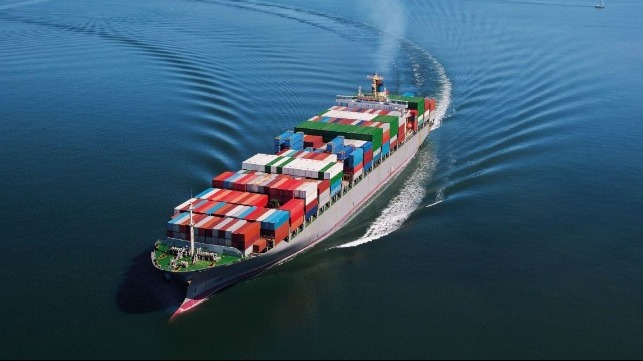Report: Converting In-Service Boxships to Methanol/Ammonia is Feasible

The feasibility of converting in-service vessels to future alternative fuels and the steps owners should be taking today to ensure their current investments and newbuilds do not become stranded assets remains one of the most hotly discussed issues in the maritime industry. Owners that have pursued the first conversions even of vessels that were built “ready” for future fuels have questioned the economics and pointed to the need to advance the technologies to make future conversions more practical. In the newbuild sector, questions remain as to the appropriate steps and if they are financially sound to prepare new ships for future fuels.
Transitioning to alternative fuels will be critical for decarbonizing shipping by 2050. The average lifetime of a ship is around 25 years meaning that owners need to develop migration paths for their current ships to meet the goals for significant carbon emissions reductions. Recognizing that shifting to alternative fuels via fleet replacement and retrofitting will take a long time, the not-for-profit, independent research Mærsk Mc-Kinney Møller Center for Zero Carbon Shipping released a report providing a technical, environmental, and techno-economic analysis of the impacts of preparing containerships for conversion to green fuels.
The center points out that shipowners are facing critical questions exploring what is entailed in converting to alternative fuels. They are looking for answers on issues including whether they should be building dual fuel ships now or if retrofitting alternative fuel capabilities later is a valid option. They are weighing the costs and exploring if preparing newbuilds for later conversion provides cost savings.
“Our analysis shows that converting vessels is technically and economically feasible, and can play a role in transitioning your fleet to alternative fuels,” writes the Mærsk Mc-Kinney Møller Center releasing its report. “What’s more, conversion has a favorable impact on lifetime emissions. However, intelligent vessel design and careful conversion and operational planning are essential to ensure conversion remains cost-effective.”
Drawing on insights from multiple project partners, they are exploring the technical requirement and costs of converting from fuel oil to methanol or ammonia or LNG to ammonia for containerships, bulk carriers, and tankers. The first report outlines the project results related to converting containerships to methanol or ammonia and will be followed by two additional reports.
For their analysis, they used a 15,000 TEU twin-island container vessel as the reference. The report assumes a cost of $150 million for the newbuild exploring the general design considerations in newbuilds that would be fueled by methanol or ammonia as well as the level of preparation during construction to accommodate later conversions.
One of the key considerations they explored is the requirements for fuel tanks, highlighting that due to the properties of the emerging alternative fuels vessels will require larger tanks to maintain their range of operations. The report points out that the optimal placement for tanks is best achieved during new construction and that retrofits are likely to reduce the containership’s capacity ranging from 240 to 1,100 TEU depending on the choice of ammonia or methanol when converting from traditional fuel oil. However, the conversion costs and cargo losses can be reduced by converting to a reduced alternative fuel range that would require smaller tanks but sacrifice the vessel’s long-range steaming capabilities.
While they highlight that converting from LNG to ammonia is less complex than converting from fuel oil to ammonia, as many of the gas-related systems required for ammonia are already in place, the challenge becomes the fuel storage tanks. LNG tanks cannot be converted to ammonia meaning that using existing tank locations is not practical and requires preplanning for future ammonia operations during construction. The additional costs of preparing a vessel for LNG, a larger tank for ammonia operation, and then converting to ammonia make this strategy relatively expensive according to the report. However, they point to the potential fuel cost savings from operating on LNG concluding that LNG-ammonia conversions are cost-effective if the conversion takes place after eight years of LNG operation for a vessel that will maintain its operating range.
Cost considerations vary greatly depending on the level of preparation made during the design and construction of the vessel and the type of conversion undertaken. They estimate that methanol and ammonia dual fuel newbuilds should cost approximately 11 and 16 more than a standard newbuild while the cost of conversion from fuel oil to a full range methanol or ammonia dual fuel vessel varies anywhere from 10 to 24 percent of a standard newbuild cost, depending on the level of preparation at newbuild. Converting to methanol is less expensive than converting to ammonia they note because fuel tanks can be sized for methanol during construction and used for fuel oil until the ship is converted to methanol operations.
The cost of taking steps to prepare a vessel for a future conversion from LNG to ammonia during construction could add as much as seven percent to the building costs. Conversion costs would be approximately eight percent of the LNG newbuild and this compares with up to a third for a standard fuel oil newbuild cost. The vessel’s lifetime economics however are also impacted by the number of years it operates before the conversion is undertaken.
The Mærsk Mc-Kinney Møller Center for Zero Carbon Shipping’s goal is to provide a detailed analysis of the considerations to help shipowners make critical decisions to speed decarbonization. They believe that with careful consideration and planning that the conversion of in-service vessels will be viable meaning that decarbonization goals can be reached before a total fleet wide replacement could be completed or creating stranded assets.
The complete report is available online.
